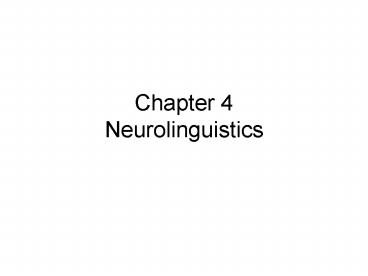Chapter 4 Neurolinguistics - PowerPoint PPT Presentation
1 / 12
Title:
Chapter 4 Neurolinguistics
Description:
Regulation: basic level of awareness and responsiveness ... of the motor cortex (i.e., articulation, respiration, phonation, resonation) ... – PowerPoint PPT presentation
Number of Views:649
Avg rating:3.0/5.0
Title: Chapter 4 Neurolinguistics
1
Chapter 4Neurolinguistics
2
Central Nervous System
- Note Figure 4.1 that shows a schematic of the
Left Cerebral Hemisphere - Note the Motor Cortex a strip that controls
motor movements and refer to Figure 4.2 - Sensory Cortex receives sensory input
- Integration of sensory and motor information for
various body functions
3
Three basic functions
- Regulation basic level of awareness and
responsiveness - Processing information is analyzed, coded and
stored requires that data from multiple sources
be analyzed, integrated, synthesized - Formulation intent and programming of behavior
motor behaviors are planned and coordinated
4
- Also,
- Executive function selective attention, goal
setting, planning and organizing - Self Regulation monitoring, evaluating and
adjusting performance
5
Hemispheric asymmetry
- Remember that neither hemisphere can function
alone, but areas of specialization is more useful - Left hemisphere is dominant for language and
speech related oral movements, BUT the right
hemisphere is used for more holistic aspects of
communication such as prosody, nonlinguistic
cues, etc.,
6
Language Development, Brain Maturation
Specialization
- Density of neurons
- Increased connections
- Importance of experiences to stimulate and
strengthen connections - For example, linking of auditory and motor areas
occurs early in 2nd year of life related to
imitation of speech sounds - As the child is exposed to and adds more
information, the information must be organized
for easy access and use
7
Language Processing
- Must attend to linguistic information
- Comprehension is dependent on processing the
linguistic information and understanding word
meanings and concepts (left hemisphere) - The right hemisphere will process the
nonlinguistic information and paralinguistic cues
8
Language Processing
- Working Memory allows linguistic information to
be held for analysis - Comprehension is also dependent upon storage of
information and complexity of the message - The exact nature of language analysis is not
known but it is a remarkable fast and efficient
system.
9
Language Production
- Begins with a concept to be communicated
- Structure of the message must be organized
- Message must be formulated programming of the
motor cortex (i.e., articulation, respiration,
phonation, resonation).
10
Information ProcessingFigure 4.6
- Attention discrimination
- Organization
- Memory
- Transfer
11
- Other processing models have been developed
- Metacognition our awareness of our thinking
processes and how we use that knowledge
12
Neuroplasticity
- When one area of the brain can take over the
function of another area































